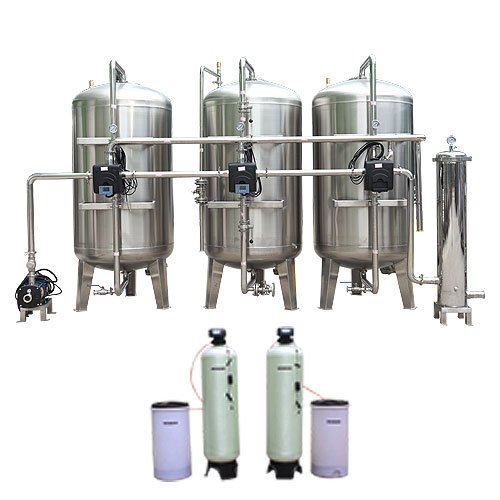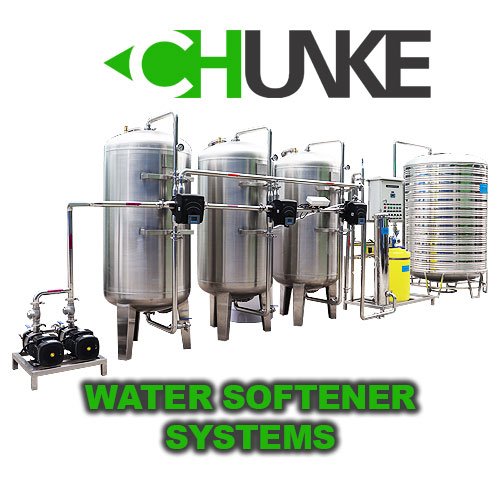Culligan water softener and Chunke Water Softener are used for same purpose. So, a water water softener removes minerals that create water hardness, one of the most common water quality problems many homeowners and engineers encounter. Meanwhile, hard water destroys appliances, leaves filmy soap scum across bathrooms and kitchens, and dries out hair and skin. Also, in industrial application, reduce end-product quality, and increase energy cost. Hence, with over 85% of the United States relying on hard water for their cooking, cleaning, and bathing, water softeners serve a vital purpose. So, a water softener saves you from replacing prematurely ruined water heaters, scaly faucet heads, and hours and hours of cleaning up soapy residue. Investing in a water softener saves you time, energy, and money, and protects your home and your property.

What Is a Water Softener?
A water softener is a filtration system that removes hardness-causing calcium and magnesium minerals from your water through a process called ion exchange. So, iIon-exchange is about the same as adsorption, and now we check how does ion-exchange process work?
Ion Exchange Definitions:
Ion-exchange is a reaction in which an ionic species, A+, in solution is exchanged with another ion species, B+, attached to a solid phase, called an ion-exchanger, designated as X.
The reaction can be depicted by
X.B + A+ —-> X.A + B+
The ion-exchanger has sites on a macromolecular or crystalline framework, for resins and minerals, respectively, to which the ions are attached. So, the number of bonding sites per unit of ion-exchanger is usually expressed as milliequivalents ion-exchange sites per gram of ion-exchanger, i.e.,meq/g.
The ion-exchanger is a solid material that provides internal sites for the bonding of ions. The target’’ ion species to be removed, e.g., Ca2+, Mg+2, the counterion, has a stronger bonding energy because of its double charge than the ion being replaced, e.g., Na+ accordingly. So, common ion-exchangers include the zeolites and synthetic resins. Usually, the reactor is a packed-bed of ion-exchanger.
More Details for Ion Exchange
Culligan water softener and Chunke Water Softener use high quality ion-exchange resin accordingly. But, Chunke can gives you option to choose brand, easily to reach in your country.
Ion-exchange has an operating cycle similar to adsorption. First, the ion-exchanger bed becomes saturated or ‘‘exhausted’’ with respect to the target ion, e.g., Ca2+ accordingly. Then, the recharge part of the cycle is started, which consists of flooding the bed with the recharge ion, e.g., Na+, in the form of a concentrated brine solution, which displaces the adsorbed Ca2þ and conditions the ion-exchanger for another
cycle of Ca2þ removal. So, to better utilize the ion-exchanger bed, two columns may be operated in series: when exhausted, the first column is removed for recharge; the second column is place at the beginning; a third standby column that has been recharged is placed in the second position.
Ion exchange process cannot reduce salt level in salt water. Chunke provide seawater desalination system and brackish water desalination system accordingly. As regards to your application, we can supply wide range of water usage system to you.
How Does a Water Softener Work ?
A water softener has a resin tank containing thousands of tiny resin beads that hold electrically charged ions accordingly. When freshly regenerated, the beads become full of sodium ions from the water softener salt. As hard water passes through the water softener system, the calcium and magnesium ions are attracted to the resin beads. There, sodium ions are exchanged for the hard water ions. So, the softener system then delivers soft water for your use.
After process, you can get drinking water or process water. Culligan water softener and Chunke Water Softener reduce hardness demanded level accordingly.
What Are the Components of a Water Softener?
A water softener is made up of three components: a control valve, a mineral tank, and a brine tank. So, these three work in conjunction to remove the minerals from hard water, monitor the flow of water, and periodically clean the system through a regeneration process.
1. The mineral tank
The mineral tank is the chamber where the hard water is softened. So, the water supply line feeds the hard water into the tank. The water seeps through the bed of resin beads, depositing the water-hardening calcium and magnesium ions. The water exits the tank soft and flows through your pipes and out to your household appliances.
2. The control valve
The control valve measures the amount of water passing through the mineral tank and into your house. So. the valve houses a meter that tracks the volume of water entering the mineral tank accordingly. As hard water flows through the mineral tank, the resin beads exchange their sodium ions for hardness ions. Over time, this depletes the capacity of the resin to continue to effectively soften water.
Before the beads become too burdened with mineral content to continue removing calcium and magnesium ions, the control valve automatically initiates a regeneration cycle accordingly. This maximum capacity is pre-programmed into the control valve’s onboard computer and is based on a range of factors, like the size of your house, the number of occupants, and the hardness of your water. Control valves are demand-initiated controllers, which allow water softening units to be extremely efficient. Meanwhile, Culligan water softener use own brand, and Chunke water softener use well-known valve brand like Fleck, Runxin.
3. The brine tank
The brine tank aids the water softening system in regeneration. It is a shorter tank that sits adjacent to the mineral tank. The brine tank holds a highly concentrated solution of salt (or sometimes potassium) to restore the resin beads’ positive charge accordingly. Salt is manually added to the brine tank in the form of pellets or blocks. These dissolve in the water at the bottom of the tank. When the control valve registers the softening capacity of the resin is diminishing, the heavy brine solution is drawn out of the tank and flushed through the resin in the mineral tank. So, if the brine tank runs out of salt, the water passing through the unit will no longer be softened.

What Is the Difference Between Culligan Water Softener and Chunke Water Softener
Culligan water softener and Chunke Water Softener is using same material for tanks and brine tanks. Chunke Water Softener advantage is you can choose FRP tank brand. We can use Pentair FRP Tank, CHUNKE FRP Tank or some other wellknown FRP tank brands in water softener accordingly.
Second, Culligan water softener is using theor own brand for Water Softener Valve. Chunke gives you option for Water Softener Valves. For example, you can choose Runxin, Fleck valves. Runxin valve and Fleck is very successful for stable water flow rate.
For the brine tank, Chunke and Culligan Water Filter are using PE material.
Both companies, Culligan Water Systems and Chunke has stainless steel 304 and 316 material ion-exchange tank option.
Advantage of Chunke Water Softener
Chunke biggest advantage for you, you do not need to buy standard design and size for your water hardness problem. Chunke can provide customize design for your water problem. You have wide range of option to choose brand, material and design. One of our commercial or industrial size water softener solve it.
When you choose Chunke Water Softener, your biggest advantage is price. Chunke Water Softener Systems is more affordable compare with Culligan Water Softener.
Today, you contact our customer service and get more information. If you need technical infiration, also our water service unit will contact you. Please kindly fill in below contact form and our technical sales team call you in 24 hours for water filtration systems.
